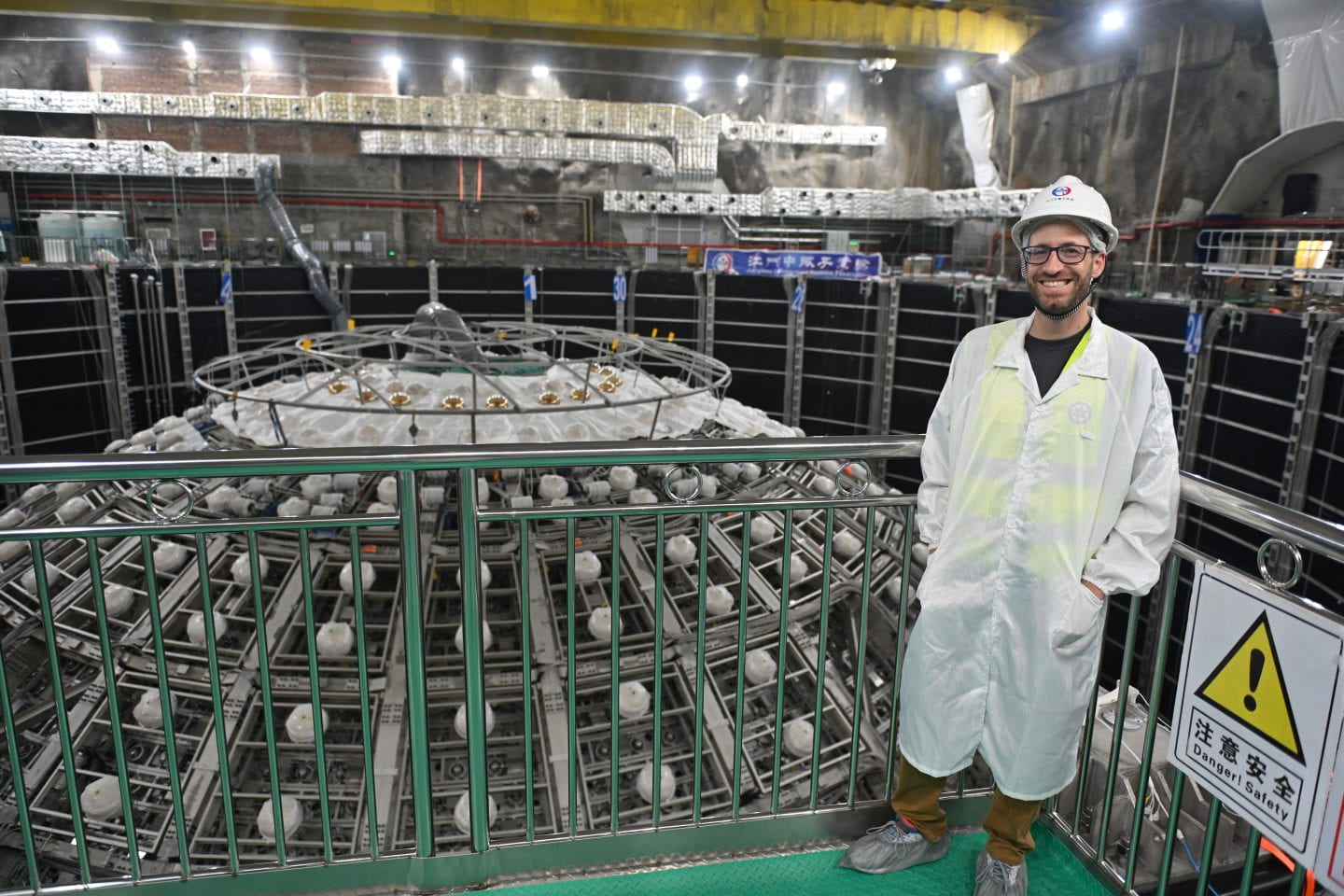UC Irvine advances neutrino science in historic JUNO project

“This is an incredibly exciting time for us. After working on the design and construction of this project for over a decade, the time has finally come when we can turn on this cutting-edge scientific instrument,” says JUNO collaborator J. Pedro Ochoa-Ricoux, professor of physics and astronomy at UC Irvine, here standing in front of the detector during construction. Yuexiang Liu / Institute of High Energy Physics
- UC Irvine researchers help launch powerful neutrino detector in China, marking new chapter in physics discovery.
- Scientists will probe the unknown ordering of masses of neutrinos – elusive particles central to understanding our universe.
- UC Irvine’s participation in the JUNO experiment is supported by the National Science Foundation.
Irvine, Calif., Aug. 29, 2025 — Researchers at the University of California, Irvine have reached a major milestone at the Jiangmen Underground Neutrino Observatory in southern China, where scientists have just begun collecting data after more than 10 years of planning and construction. Deep beneath Dashi Hill, in the Guangdong province, JUNO’s massive, state-of-the-art detector will help researchers tackle one of particle physics’ biggest mysteries: the ordering of the three neutrinos by mass. UC Irvine is the only institution in the United States with full membership in the JUNO scientific collaboration.
The detector features a groundbreaking system that lets scientists detect neutrinos – tiny, nearly invisible particles known as “ghost particles” because they pass through people and even whole planets without leaving a trace. The neutrino was co-discovered by UC Irvine physicist Frederick Reines, earning him the 1995 Nobel Prize in physics.
By capturing, counting and measuring these elusive particles, JUNO will help researchers answer important questions about how the universe works, from what happens inside exploding stars to the composition of Earth’s interior. UC Irvine’s team has played a key leadership role throughout the project, from its inception to now analyzing the first waves of data.
“Making progress in fundamental particle research these days requires experts from all over the world collaborating on very large, complex projects such as JUNO,” said team member J. Pedro Ochoa-Ricoux, professor of physics and astronomy at UC Irvine. “This is an incredibly exciting time for us. After working on the design and construction of this project for over a decade, the time has finally come when we can turn on this cutting-edge scientific instrument.”

Neutrinos are among the least understood particles in the universe, challenging established models of physics due to their extremely small mass and ability to change type – a phenomenon called neutrino oscillation. JUNO’s innovative approach enables a direct determination of whether the third neutrino mass state (ν₃) is heavier than the second (ν₂) or vice versa – a discovery with broad implications for the Standard Model and possible new physics.
Determining which neutrino state is the heaviest would not only mark a major step forward in understanding the fundamental makeup of our world but also enable scientists to use neutrinos more effectively to probe the sources that produce them and to reveal their role in shaping the universe.
“JUNO is especially suited for measuring low-energy neutrinos from reactors, the sun, Earth and supernova explosions,” Ochoa-Ricoux explained. “The measurements we will make with this detector are complementary to those from experiments such as the Deep Underground Neutrino Experiment, in which UCI is also a key collaborator.”
UC Irvine’s involvement in JUNO includes hands-on contributions to design, assembly, commissioning, analysis and project leadership by postdoctoral scholar Sindhujha Kumaran; grad students Katherine Dugas, Adrienne Jacobi, Roberto Mandujano and Zhongyi Wu; and undergraduate students Brian Wen Cheng and Samantha Cantu Olea.
The university’s participation in the JUNO experiment is supported by the National Science Foundation.
About UC Irvine’s Brilliant Future campaign: Publicly launched on Oct. 4, 2019, the Brilliant Future campaign aims to raise awareness and support for UC Irvine. By engaging 75,000 alumni and garnering $2 billion in philanthropic investment, UC Irvine seeks to reach new heights of excellence in student success, health and wellness, research and more. The School of Physical Sciences plays a vital role in the success of the campaign. Learn more by visiting https://brilliantfuture.uci.edu/uci-school-of-physical-sciences.
About the University of California, Irvine: Founded in 1965, UC Irvine is a member of the prestigious Association of American Universities and is ranked among the nation’s top 10 public universities by U.S. News & World Report. The campus has produced five Nobel laureates and is known for its academic achievement, premier research, innovation and anteater mascot. Led by Chancellor Howard Gillman, UC Irvine has more than 36,000 students and offers 224 degree programs. It’s located in one of the world’s safest and most economically vibrant communities and is Orange County’s second-largest employer, contributing $7 billion annually to the local economy and $8 billion statewide. For more on UC Irvine, visit www.uci.edu.
Media access: Radio programs/stations may, for a fee, use an on-campus studio with a Comrex IP audio codec to interview UC Irvine faculty and experts, subject to availability and university approval. For more UC Irvine news, visit news.uci.edu. Additional resources for journalists may be found at https://news.uci.edu/media-resources.
